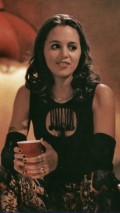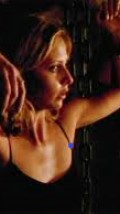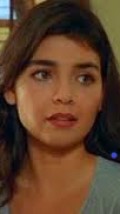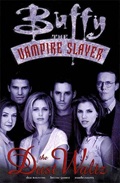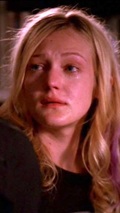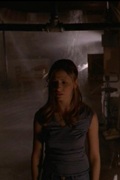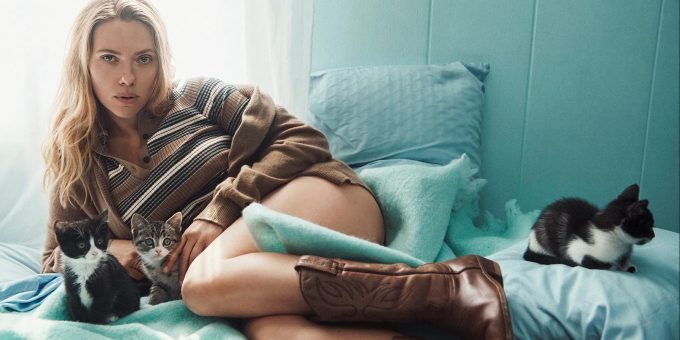
The director of Eleanor the Great and star of Jurassic World Rebirth on being sexualised as a teen, how “we’re being muzzled” by Trump’s tech allies, and more.

“Whatever kind of diner food you’re into is going to be delicious – and also enormous.”
Scarlett Johansson is priming me on what to order at the Ritz Diner, a 60-year-old institution in her Upper East Side neighborhood. She’s just walked in wearing bulky circumaural headphones, a plush turquoise turtleneck, and an old Yankees cap, and we’re sitting in a small booth by a window with the blinds closed. Today may technically still be in the midst of a dreary New York winter, but this buoyant mid-March afternoon – the temperature inching toward 60 degrees, the sun brightly shining – is signalling the beginning of spring. Before ordering a turkey sandwich on rye, Johansson suggests a change in the season will do us all some good: “It’s such a weird time.”
She smiles the kind of nervous smile my mother gives me when she’s spent too many hours doomscrolling. “For me, there’s a blanket of unease,” she says. “Every day it feels like you’re going to get hit with some news that’s disturbing.” She asks for a black coffee and a seltzer. I tell her my husband is urging me to disable push alerts on my phone. “No, I get it,” she says. “It’s awful. I’m thinking, Should I just get rid of my whole news feed now?”
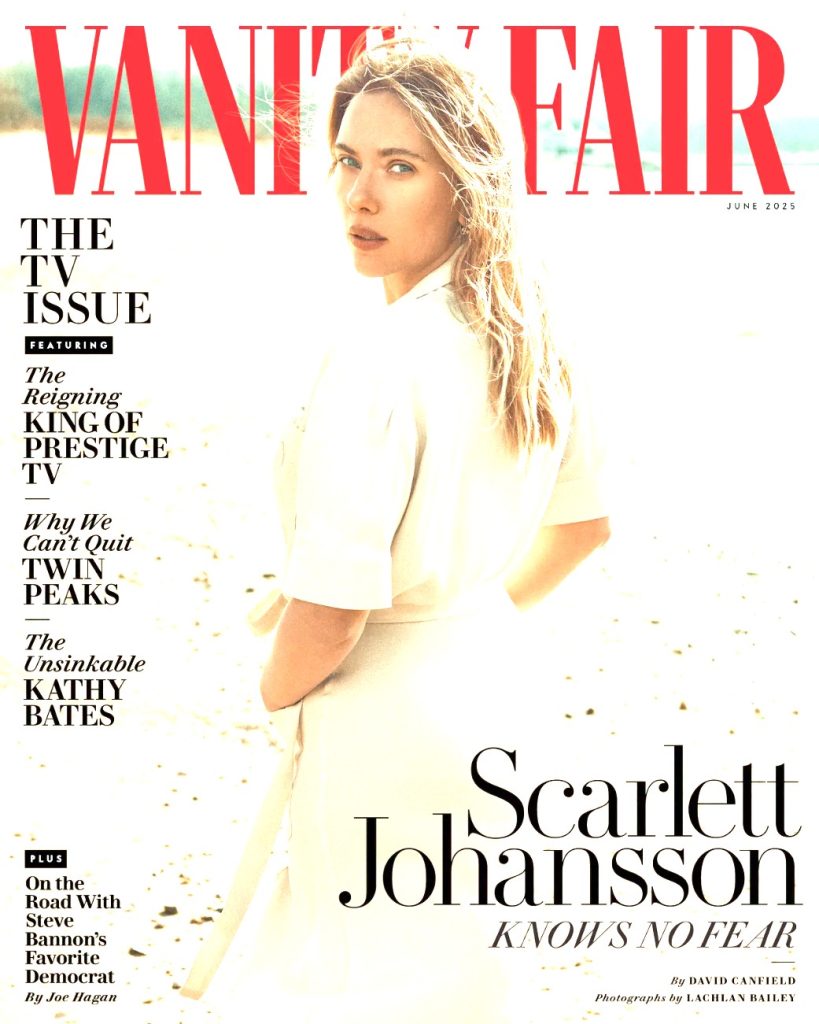
We trade a few more stores about general political anxiety before Johansson downloads me on her experience at the Oscars from a week prior. She presented alongside June Squibb, the 95-year-old star of Johansson’s feature directorial debut, Eleanor the Great – which, it just so happens, includes the Ritz Diner as a key location. They nailed a bit about Squibb actually being the latest disguise of 34-year-old Bill Skarsgård, the hunky shape-shifting star of Nosferatu and It. “June was so excited, it made me feel excited too,” Johansson says. Otherwise, she has some beef with the Oscars telecast: “Why was it so long?” I suggest that the elongated tribute to the James Bond franchise might be one possible culprit. “No comment,” Johansson says, then comments, “It felt like a ad placement. What a weird thing.” She didn’t watch the whole tribute but gauged the reaction at an after-party. “People were like, ‘What the hell was that?'”
“She always seemed confident about directing – since I met her, when she was 17,” says Sofia Coppola.
Johansson last attended the Oscars five years ago, when she was a double nominee for her devastating turns in Marriage Story and Jojo Rabbit. Back then, Hollywood’s resistance to Donald Trump remained voluble. Now he’s barely acknowledged and public events, including the Academy Awards. I ask what Johansson thinks of this shift, since before Trump’s reelection she’d called the idea of him becoming president again “unfathomable.” She reminds me of who attended Trump’s inauguration in January.
“These are people that are funding studios. It’s all these big tech guys that are funding our industry, and funding the Oscars, and so there you go,” Johansson says. “I guess we’re being muzzled in all these different ways, because the truth is that these big tech companies are completely enmeshed in all aspects of our lives.” How do you fight that? “I don’t know how you fight that,” she says, pointing to The Apprentice, the lightening rod Trump tale starring Sebastian Stan that most studios refused to touch. (It was acquired by the small distributor Briarcliff Entertainment and received two Oscar nominations.) “Here’s where you would go, ‘Okay, you can fight it by making stuff like that,'” she says. “But then what happened with the release? It was buried.”
As her friends will tell you, Johansson is among the most outspoken A-listers we’ve got. “There’s leadership quality inherent in everything she does,” says her fellow Avenger Robert Downey Jr. In 2021 Johansson sued the Walt Disney Company after the studio released Black Widow simultaneously in theaters and on Disney+, which was a watershed moment in actors’ fight for fair compensation in the streaming era. After reaching a settlement, she got right back into business with the Mouse House, spearheading a Tower of Terror movie, which she is still working on.

She also called out AI companies for appropriating her likeness and (allegedly) her voice, and is advocating for legislation to curb the technology. She laments to me, however, that she’s felt on her own there. “There has to be some agreed-upon set of boundaries in order for [AI] to not be detrimental. I wish more people in the public eye would support and speak out about that – I don’t know why that’s not the case,” she says.
Johansson keeps close tabs on the Hollywood landscape. She’s trying to make hits in the most unpredictable moviegoing climate in recent memory and wants to resurrect the kind of ’90s big-screen magic that was more prevalent around the beginning of her career and her own adolescence. This is not new: Johansson was only 12 years old when she first realized she wanted to be a director. She had already appeared in a half dozen films a s kid and was on the precipice of her big break in Robert Redford’s sweeping Western tearjerker The Horse Whisperer. Redford was also directing that movie, and Johansson could sense his vision, his command behind the camera, his sensitivity as a mentor. “He would sit me down and take such time talking me through all of the events that led up to the moment in the film – and where I was mentally,” she says. “I’d never experienced anything like that.”
Her interest only grew from there. “She always seemed confident about directing – since I met her, when she was 17,” says Sofia Coppola, who directed her in Lost in Translation. But Johansson then helped lead the billion-dollar grossing Marvel Cinematic Universe, at one point becoming Hollywood’s highest-paid actress. She is raising a family with her husband, Saturday Night Live‘s Colin Jost. Directing was never off the table, but a whole lot of life got in the way until now.
It’s almost my responsibility to come up with some way to burn Michale back,” she says of SNL‘s Michael Che
Johansson was right: The sandwiches are big. More than half an hour in, we’re chatting with nearly untouched halves in our plates, We talk about the SNL tradition in which her husband and his Weekend Update cohost. Michael Che, read each other’s crudest jokes off a teleprompter without knowing the contents in advance. Che’s steadiest target? His colleague’s wife. “Costco has removed the roast beef sandwich from its menu,” Jost nervously began on a December show. “But I ain’t trippin’. I’ve been eating roast beef every night since my wife had the kid.” Johansson was in the studio watching the monitor. The camera caught her horrified laughter.
“I had all those cameras on me. I didn’t expect the setup to be like that,” she says to me now. “I was like, ‘Wow, you really are seventh-, eighth-grade boys.'” She grins out of nowhere: “I feel like it’s almost my responsibility to come up with some way to burn Michael back. Retaliation, I’d say, should be expected. Others on the show could support this desire. Know what I mean?” Her eyes sparkle as though there is a plan in the works, and after our interviews, SNL announces that Johansson will host this year’s season finale.
She gulps down another mug of drip. “You just have to be careful how much coffee you drink in a diner,” she says. “You’ll be like, bz!! We pay up front and buzz out of the Ritz. Johannsson likes the idea of taking a walk. “Gotta be careful of the bike lane,£ she says, and leads me on a brisk march up First Avenue.
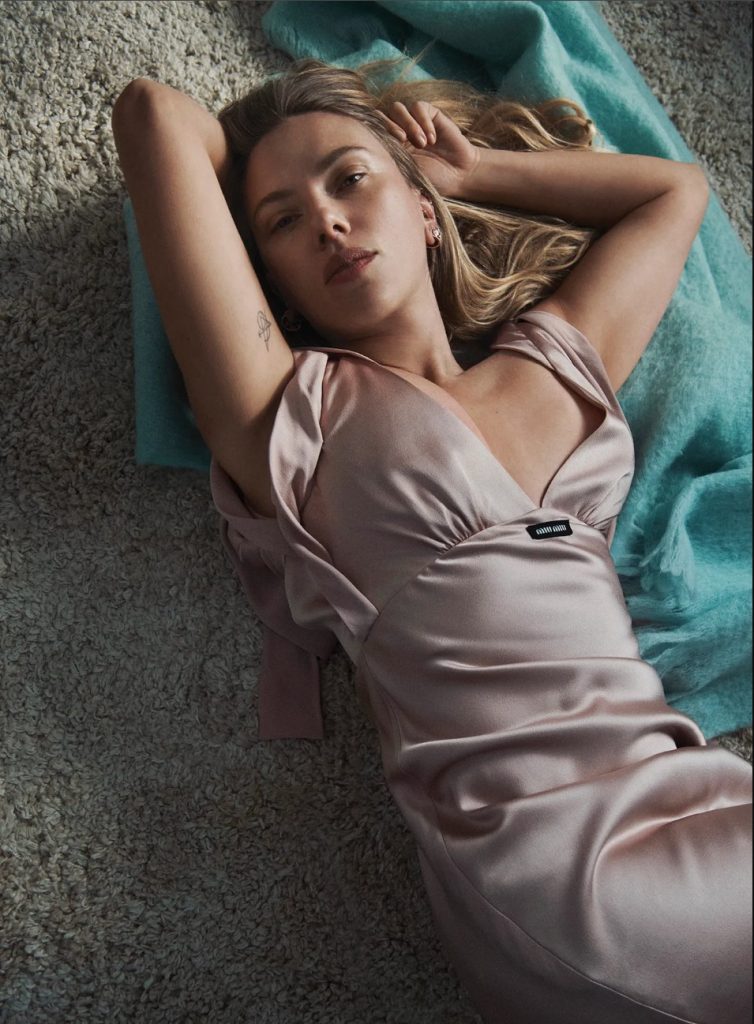
Born nearby at Lenox Hill Hospital, Johansson was raised in a big family, mostly in Lower Manhattan. At the age of eight, she was already acting in an off-Broadway play starring Ethan Hawke. Her film debut came not long after in 1994 with Rob Reiner’s North, and she earned great notices for her lead turn in the 1996 realist indie Manny & Lo. Coppola highlights that movie as the one that put Johansson on her radar.
We’re near the tram for Roosevelt Island, which sparks my own flashback, having lived there after college with my parents. The connection between people who’ve inhabited that strange sliver of land, nestled between Queens and Manhattan’s East Side, is uniquely strong. Turns out that Johansson is part of the club. When she was 10 she moved there with her family for a year while they were between apartments. “I haven’t been there in a long, long time,” she says. “Remember how the main street had one Chinese restaurant, one pizza place, and one diner?” I assure her that, at least as of a decade ago, it still did.
Johansson’s parents divorced when she was 13 and, eventually, lived on opposite coasts. Her mother jetted from set to set as her chaperone. there was a Coen brothers movie (The Man Who Wasn’t There), a beloved teen cult classic (Ghost World), some duds (remember My Brother the Pig?) Johansson worked regularly while attending Professional Children’s School, a private institution whose student demographic is right there in the name. “Making decisions on your own – like, adult decisions as a kid – it’s a dangerous thing, right?” Johansson says. In the last few years, she’s read Jennette McCurdy’s memoir I’m Glad My Mom Died and watched the doc series Quiet on Set – two harrowing accounts of child stardom gone awry. “I lived through that and also was very fortunate that I dodged a lot of it.”
One of the last times her mother accompanied her on set was for Lost in Translation. Johansson was 17, living in Tokyo, and profoundly lonely. In the film she beautifully portrays an alienated recent college graduate who forms a tight bond with a gloomy American movie star played by Bill Murray. Art, in this case, did not imitate life. Johansson was a massive fan of Groundhog Day and What About Bob? from childhood but says of Lost in Translation, “Bill was in a hard place. Everybody was in tenterhooks around him, including our director and the full crew, because he was dealing with his…stuff.” She’d never encountered an actor in that kind of “headspace,” as she diplomatically puts it, and was left at sea. All eyes were on him; she could only look inward.
Earlier this year Johansson ran into Murray at Saturday Night Live‘s 50th-anniversary special. He interacted warmly with others on set, and she heard stories about him rallying the sketch show’s writers with inspiring earnestness. “He’s such a different person now,” she says. “I think life has humbled him.” I ask if she’s referring to the recent allegations of misconduct against him. (In 2022, production was suspended on the film Being Mortal after a female crew member reportedly alleged that Murray engaged in inappropriate behavior with her, Murray said at the time, “I did something I though was funny, and it wasn’t taken that way.”) “Certainly, yes – that was really bad,” Johansson says. “But I also know COVID was a hard thing for him. Life – all these things have led up to him being accountable for that kind of behavior.” She adds later. “But you know what? How wonderful that people can change.”
Johansson still looks back on Lost In Translation with some fondness. “I’m pretty proud of how I handled myself. I really just did the work, you know? It’s a good tactic for pushing through stuff.” She looks off in the distance, then says quietly, “Eyes on the prize.” A brief silence falls. The phrase is an apt motto for Johansson. Even gliding through New York, she’s fast and focused. We’ve been walking uptown on some kind of mission with no end in sight. I don’t know where we’re going, but she clearly does.
Except at one point, she suddenly stops in front of a toy store. It looks a little weird and barren from the outside, and she wonders aloud if it’s a drug front before cheerily making her entrance. She starts browsing. “I have thoughts,” she whispers. No music is playing and we’re the only customers. She is after a specific item: “Something to occupy my kids in the car.” She settles on Totally Dotty Dot-to-Dots, a fairly heavy puzzle and activity book. “You never get to go inside a toy store – there aren’t many anymore,” she says as she walks up to the register. After we exit, she observes, “That definitely had a pet-store smell.”
Maybe it’s the first-day-of-spring weather, but the city seems to open up once we resume walking. She spots one of her favorite grocery stores. She points out rows of lovely old town houses. She’s flabbergasted by a fruit stand: “Look at those bags of cherries. That’s like a bajillion cherries. A five-pound bag!” We turn right on 86th Street, toward the river; we arrive at Carl Schurz Park, another landmark from Johanssons’s first feature film, Eleanor the Great. The park overlooks – but of course – Roosevelt Island. “Let’s go find Eleanor’s bench,” she says.
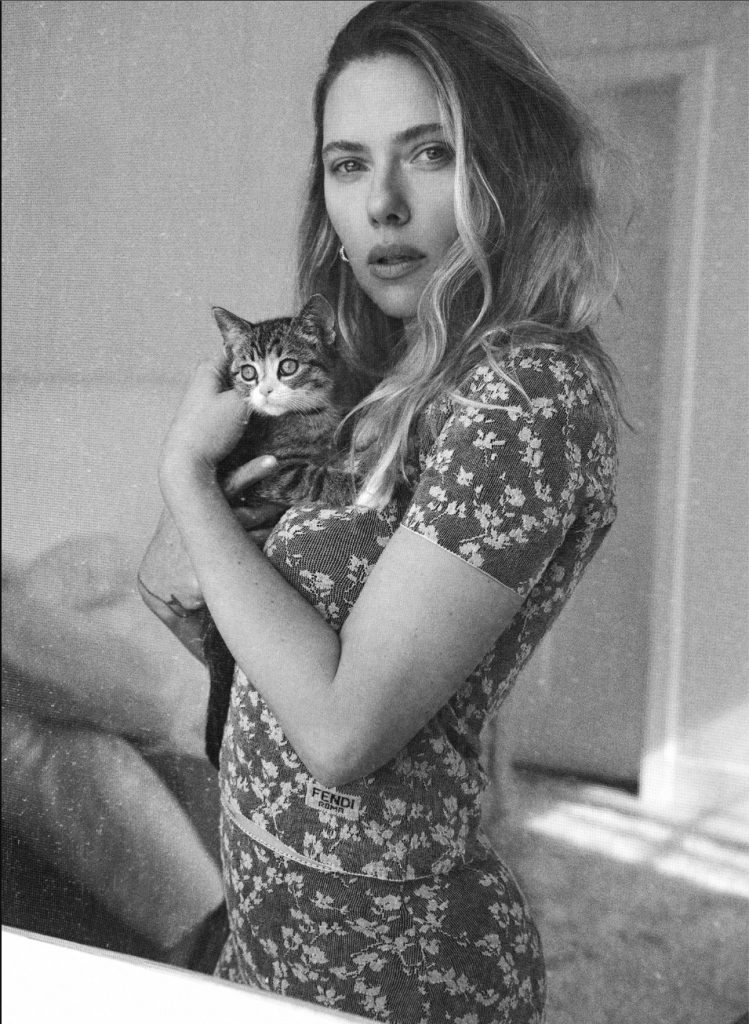
Well, Eleanor’s bench is taken. Every bench is, New Yorkers aren’t going to waste a day like this. We snag a spot that’s just been vacated, and Johansson slips off her turtleneck. “Oh, yes, baby,” she yelps toward the East River. “We’re going to bag to some rays.” She leans back in her white tank top and closes her eyes.
Johansson made Eleanor the Great a hometown gig, shooting all around her upper Manhattan digs, along with a quick detour to Coney Island, where she spent time with her grandfather as a kid. The film follows Squibb’s Eleanor, a retiree who leaves her Florida apartment behind after her roommate and best friend, Bessie (Rita Zohar), passes away. She moves in with her daughter (Jessica Hecht) in New York and starts attending a Holocaust survivors group. The problem: Eleanor is not a survivor. She’s appropriating Bessie’s story, a convoluted but human act of deception born out of grief, loneliness and maybe boredom.
It’s a brilliant showcase for Squibb, who was Oscar-nominated for Alexander Payne’s Nebraska and earned acclaim for last year’s Thelma. In fact, the whole cast shines: Erin Kellyman as a student journalist intrigued by Eleanor; Hecht, who costarred with Johansson in a 2010 A View From the Bridge Broadway revival; and Zohar, a veteran actor who once starred in Yiddish theater and whose performance is richly affecting. Johansson’s deftness as an actor’s director is obvious. But pulling off such a polished, appealin crowd-pleaser for a budget of next to nothing? That was hardly guaranteed.
“I was amazed at how pen she was,” Squibb tells me. “there’s no playing around. There is absolutely no shit about her at all. Who she is is who you’re getting all the time.” I ask Squibb why she thinks that is. “I do think she likes herself – I think Scarlett enjoys being Scarlett,” she says. “This is positive, because it allows her to say, ‘This is who I am, take it or leave it.’ I think that’s how she goes through life, basically.”
The script by Tory Kamen came to Johansson through her production company, These Pictures. It felt like the right time to take the plunge. “It reminded me very much of those independent films from the ’90s like Living Out Loud,” Johansson says. Growing up, she was very close with her Jewish grandmother: “I could identify with that part of the story. If I didn’t, it would be more challenging, It think, and maybe not totally appropriate for me to direct it.” She quickly learned how difficult it is to finance a small character study these days – especially when your star is in her 90s. “It fell apart so many times,” she says. “Independent finance people would go, ‘Oh, you want to make this next spring?’ I was like, ‘No, I don’t know if you heard me. The lead actor is 94. She’s up to make this now.'”
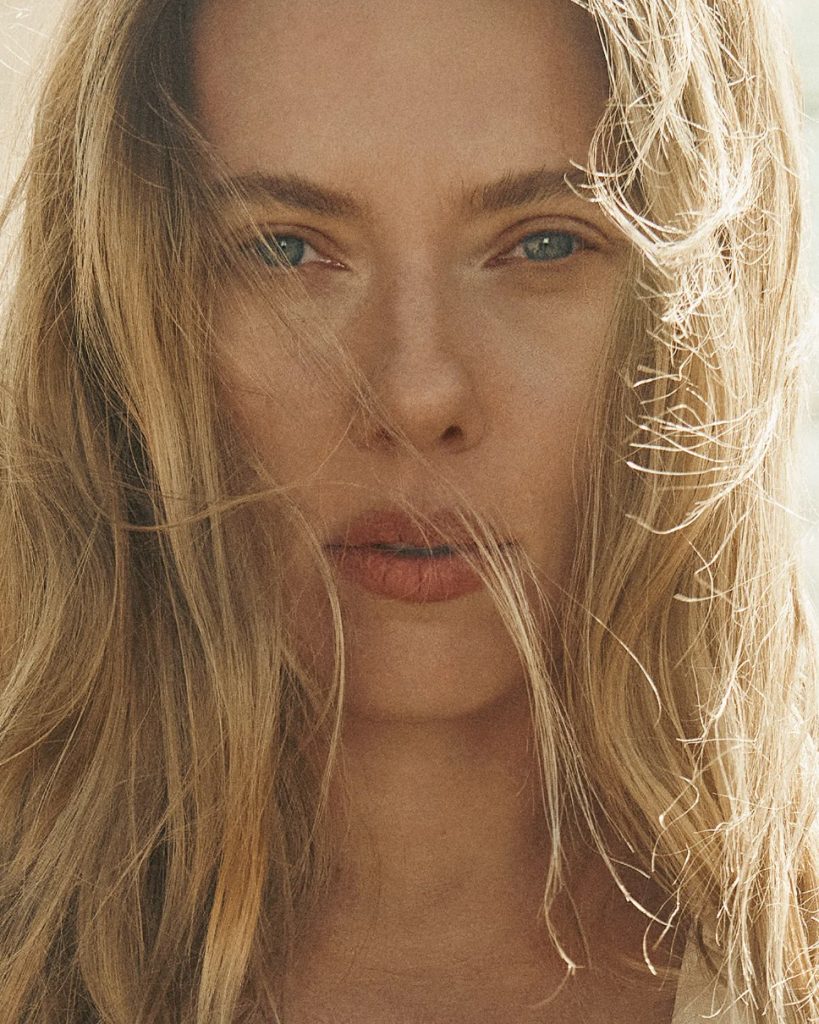
As we speak, Johansson has submitted the movie to the Cannes Film Festival. She’d dearly love for it to premiere there, and she’s anxious since she hasn’t heard back: “What’s taking so long? What’s going on?” (It will ultimately be accepted by Cannes.) Sony Pictures Classics is expected to release Eleanor in the fall, with another prominent backer being Wayfarer Studios, the production company founded by Justin Baldoni. Johansson never met Baldoni because he was busy making It Ends With Us, the source of his explosive legal battle with Blake Lively, who’s accused Baldoni of sexual harassment (he denies the allegations and is suing Lively for defamation, among other claims). When I bring up Baldoni, Johansson lets out a loud, knowing laugh. That’s the standard reaction these days, given how public the feud has become. “They were super supportive throughout the process,” she says of Wayfarer. “But yeah, such weird timing.”
While she was shooting Eleanor, Johansson locked in another huge opportunity: the lead of the upcoming movie Jurassic World Rebirth. She went to make that tentpole across the globe right after filming on Eleanor finished. How different does she think the movies’ budgets were? “I’d say Eleanor was, like, 300 times less.” Her smirk implies a smidge of hyperbole, but this is someone who’s long understood how to balance the multiplex with the art house.
After wrapping an exhausting day on Rebirth, she’d shift into Eleanor postproduction mode. “I was far away, so the time difference worked out where I could then go straight into editing, which was wonderful,” she says. Eleanor came in tight, well under two hours. “Movies are so long now – they’re too long, don’t you think so?” she says. “It feels like a chore.” She’s very pleased that Wes Anderson cut his latest movie, The Phoenician Scheme, in which Johansson plays a small but memorable role, down to an hour and 41 minutes.
Johansson stands at the park’s railing to fully take in the view. “Isn’t it heaven?” she asks. “God, I haven’t felt the sun on my skin for so long.” She’s loosened up in the few hours we’ve been together. When I ask her how she feels about interviews these days, she answers quickly: “I’m always kind of wary because they’re so subjective.” There have been times when journalists wrote up seemingly genuine conversations in ways that surprised her and felt unfair. “I love to talk, and I love to listen and share stories and commiserate and open up – I’m a pretty open book, I think,” she says later. Then she seems to catch herself: “I mean, of course, I’m guarded in some ways – like we all have to be.”
When she was in her teens and early 20s, Johansson was consistently – and blatently – objectified by male and female journalists alike. “The person would be, like, describing my body – and you wouldn’t expect that to be what the takeaway was,” she says. “They were just staring at my lips that whole time? That’s so rude.” She brings up a recent Instagram video posted by Millie Bobby Brown calling out journalists by name who’d written disparagingly about her appearance. “She’s 21 years old, and these are visible writers,” Johansson says. “I guess they still do that. I don’t think people can do that.”
This dynamic fed into a period of professional dissatisfaction for Johansson, in part why she’d considered directing so strongly. “After Lost in Translation, every role that I was offered for years was ‘the girlfriend,’ ‘the other woman,’ a sex object – I couldn’t get out of the cycle,” she says. “It sort of felt like, ‘Oh, I guess this is my identity now as an actor.’ There wasn’t much I could to with that.” Her representatives at the time did not help. “They were reacting to the norm,” she says. “The industry worked like that forever.”
But it’s especially hard to navigate when this treatment coincides with the shift into adulthood. “You come into your sexuality and your desirability as part of your growth, and it’s exciting to blossom into yourself. You’re wearing the clothes you want, you’re expressing yourself, then you suddenly turn around and you’re like, ‘Wait, I feel like I’m being’ – I don’t want to say exploited because it’s such a severe word.” I tell her the word doesn’t sound wrong to me. Johansson nods. “That term is so heavy, but yeah, it was a kind of an exploitation.”
“Once someone is successful it’s easy to think they were always successful, but she overcame more than anyone realizes to get to where she is,” Jost tells me via email. “She doesn’t lose sight of that when considering what other people are going through.”
Two 2010 projects transformed her career: the aforementioned A View From the Bridge play, for which Johansson won a Tony Award, and Iron Man 2, which turned her into a bona fide movie star. But Johansson was not the first choice to play Natasha Romanoff, a.k.a. Black Widow – Emily Blunt was offered the role. “It felt like everything was aligning, and then it didn’t happen, and I was really devastated by it,” Johansson says. Later, when Blunt had to decline the part because of a conflict, Johansson got what she dubs “the best call ever,” “I remember Scarlett’s camera test like it was yesterday,” Downey tells me. “She leaned into the Black Widow vibe, and we were transfixed. There was this confident stillness and fierce quietness – I’d never seen anything like it. Then we’d call ‘cut’ and she’d flip back into her funny, accessible self, like an on-off mega-charisma switch.”
Johansson went on to star in the Avengers films as the MCU’s most prominent female cast member before bidding farewell with Black Widow. Even though folks like Downey and Chris Hemsworth are making their way back in various forms for Avengers: Doomsday, Johansson really meant goodbye. “It would be very hard for me to understand in what capacity [returning] would make sense for me, for the character that I play,” she says. “I miss my buddies and really would love to be with the forever, but what works about the character is that her story is complete. I don’t want to mess with that. For fans too – it’s important for them.”
Johansson never got trapped in the blockbuster box anyway. She started her production company in 2017. She gave a magnetically unsettling performance in Jonathan Glazer’s avant-garde thriller Under the Skin, then pulled off those two Oscar noms for Marriage Story and Jojo Rabbit in the same year. Jost says the latter affected him more than any of her performances in the eight years they’ve been together: “her real-life charm comes through in that movie in a way I hadn’t seen before. I don’t know if anyone else could have pulled off that role in the same way. It’s special.”
This period also necessitated some “huge learning experiences,” Johansson says. In 2018 she was preparing to play a trans man in a movie called Rub & Tug and held firm after backlash before later dropping out. “Sometimes, it’s better just to listen,” she says. The film never got made with another actor either, which disappointed her. She suggests that the character’s identity – a criminal with a dark past – was too thorny for Hollywood: “It was like, ‘We should still make this film with the right cast.’ But it didn’t seem possible without really angering someone. It’s unfortunate because those stories should be told. They need to be told.”
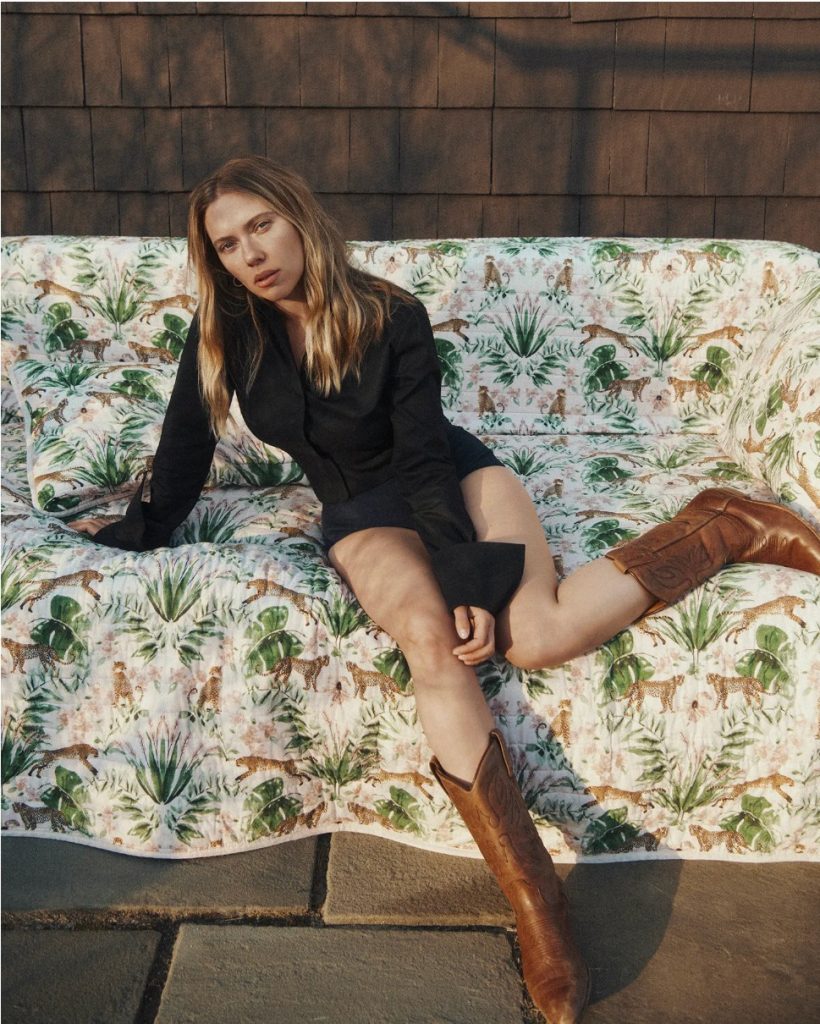
With Marriage Story she’d started filming just after divorcing her second husband, Romain Dominic, with whom she shares a daughter, (She had a child, her second, with Jost in 2021.) “I’d check in with her as I was writing, and we would hang out and have these long talks about our own experiences and the emotional world of divorce – and how it changed us” director Noah Baumbach tells me. The work shows: Johansson has never been so raw on camera. But as she made the campaigning rounds, she was rankled by the lack of recognition of her third 2019 film: Avengers: Endgame. Johansson takes her craft seriously and thinks commercial viability should not hinder a movie’s reputation.
“How did this film not get nominated for an Oscar?” she says, referring to the best-picture category. (Endgame was nominated for its visual effects.) “It was an impossible movie that should not have worked, that really works as a film – and also, it’s one of the most successful films of all time.”
Jurassic World Rebirth ought to be Johansson’s next box-office smash, based on how the franchise’s last few movies have performed. making the film tested Johansson to trust her instincts, a frequent struggle for her. On the final days of production, she was shooting the introductory scene for her character, Zora, a covert-ops expert. The setup in Brooklyn was hectic: Zora gets into a car and meets the man trying to recruit her to locate valuable genetic material at the site of a research facility in the original Jurassic Park. Zora only agrees after getting out of the car and being promised a hefty sum. Each take required circling the block in real gridlock traffic. “Once the scene ends, we have 10 minutes of driving around in bumper-to-bumper traffic to get us back to this setup point, and it’s just so long in between each take that you can’t get any momentum,” she says.
Amid the chaos, director Gareth Edwards asked that Johansson play the scene more “inscrutably,” as she remembers it – and she didn’t agree. Still, she tried adjusting herself to meet the direction. “Thirty minutes go by and I’m doing this again, and I’m looking at the floor and I’m like, ‘No! No, this is not right. This feels wrong.'” Luckily, she had those earlier takes in the can.
“Shooting in a monsoon is not ideal,” Johansson says of the new Jurassic World movie. She watched the Thailand edition of The White Lotus with envy: “I was like, ‘That’s when to do it. Different season!'”
As we speak, neither Johansson nor I have seen any footage yet, so we decide to talk again once we have. We walk another 20 or so minutes before splitting off somewhere in Manhattan. Weeks later we catch up. The “blanket of unease” that Johansson described when I first met her is worse, if anything, with the president’s extreme initial tariff plan just announced. “It’s really scary,” she says over Zoom. “The unease remains.”
Johansson has now watched a handful of scenes while completing postproduction audio work and flown to Las Vegas for a rousing presentation of film footage at CinemaCon. I also got a glimpse of unfinished snippets on the Universal lot, including that tricky car scene. My guess is they used one of those early takes. The Zora we meet in the scene is cool, collected, and clear about what she wants. She’s smart, she’s a leader, she takes no bullshit. If nothing else, Johansson herself is certainly coming through in the role. “I thought of you, actually,” she says, after her own viewing seemed to confirm the use of an initial take. “I was happy. I’m so glad.”
The Rebirth reel screened for me felt like a spirited, transporting throwback, stuffed with Steven Spielberg homages while propelled by a true sense of adventure that gets lost in most IP sequels. Also, it’s a little goofy. The script is by David Koepp, who wrote the original Jurassic Park and hasn’t contributed to the film franchise since the ’90s. Edwards, the director, is an avowed Spielberg acolyte.
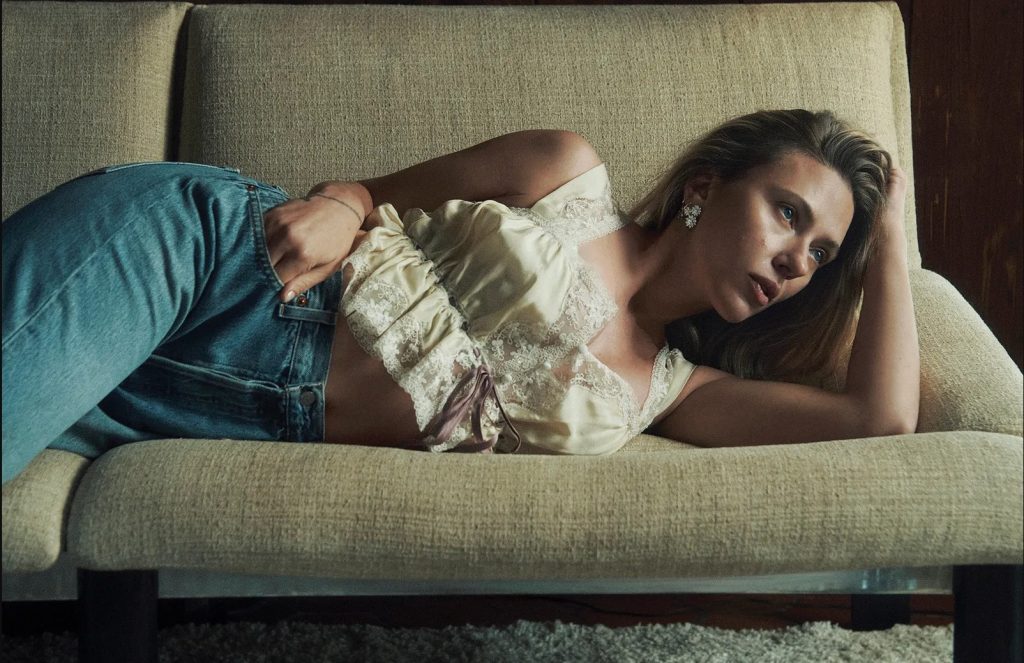
PHOTOGRAPH BY LACHLAN BAILEY, STYLED BY GERALDINE SAGLIO
The film takes gorgeous, sometimes terrifying advantage of shooting in Thailand – not that they had a choice. “They’re building floors in the rainforest and bringing in electricity and all the comfort stations for people, and then they have to pack everything out and leave it untouched – but we shot in monsoon season, so then a flash flood would wash half the set away,” Johansson says. “Shooting in a monsoon is not ideal.” She later watched the Thailand-set edition of The White Lotus with envy: “I was like, ‘That’s when to do it. Different season!’
Johansson’s costar Mahershala Ali found her to be a calming presence amid the hairy conditions. “It may take you four months in three different countries to complete a scene, and none of that was shocking to her – but for me, that was jarring, if I’m totally honest,” says the two-time Oscar winner. “As you begin to respond or freak out to certain asks, or to the reality of shooting something that big, you can look at Scarlett and see how grounded she is. I could feel her experience.”
Rebirth, which hits theaters on July 2, is set five years after Jurassic World Dominion. It turns out that the island that’s home to the research facility, where Johansson and company are left stranded, is also home to dangerous failed dino experiments. Johansson is thrilled with what she’s seen so far. And why not? She’s been trying to get cast in a Jurassic movie for more than a decade. She loves the property and believes in the enduring potential of franchises. “Terminator 2 is one of the best movies ever made,” she says, admiring “fresh ideas and great nostalgic elements that play well together. It’s about mindfulness and not being lazy.”
There’s something to Rebirth and Eleanor the Great hitting theaters in the same year for Johansson. Both fulfill near-lifelong goals and demonstrate what her decades in the business have yielded – in the former’s case, a seamless transition as the new face of a billion-dollar franchise, and in the latter’s, running her first feature set as if it’s her 20th. (“The leader was always Scarlett,” Squibb says.) Both also speak to a nostalgic style of filmmaking that Johansson tends to circle around.
As she gets deeper into making her own movies, she’s been trying to understand what’s working in theaters versus how fully streaming is taking control. “I spend a lot of time trying to unlock it. Fellow actors that are also producing think about this too. Hemsworth and I talk about it a lot,” she says, meaning Chris, of course. “But people often forget that it’s a business. Even creatives forget that it’s a business.” Johansson does not. She’s thoughtful but practical – and, judging from following her around Manhattan a little while, she’s got a pretty good sense of direction.
HIAR, JAMES PECIS; MAKEUP! MARK CARRASQUILLO; MANICURE, MEGUMI YAMAMOTO; TAILOR, CARL AI; SET DESIGN, GERARD SANTOS. PRODUCED ON LOCATION BY FARAGO PROJECTS. FOR DETAILS, GOT TO VF.COM/CREDITS
Original article at Vanity Fair
This article has been reproduced for archive purposes, all rights remain
